I have a confession to make: I love confessions. I spent countless hours in the late 1990s listening to sports radio dissect Mark McGuire’s acknowledgement of steroid use. And who did not get chills reading Perry Smith’s account of the Clutter family murders in Capote’s In Cold Blood?
However, the admission of transgression that captivated me the most over the last decade did not receive the kind of attention it likely deserved. Richard Fisher corroborated (January, 2016) that the Federal Reserve front-loaded a tremendous asset rally starting in 2009. The former President of the Federal Reserve Bank of Dallas candidly explained that committee members, himself included, set out to create a wealth effect, regardless of how mal-investments would reverse the effect in future years.
Some argue that Fisher’s confession was not particularly earth-shattering. After all, many market observers understood what the Fed had been trying to accomplish from the get-go. The Fed manipulated borrowing costs lower and increased capital at member financial institutions so that those banks would lend money to households, businesses and governments. The demand for risk-on assets from stocks to higher-yielding debt to real estate skyrocketed.
It is worth noting that Fisher implicated other central banks as well. With regard to what drove the remarkable bull market in stocks, he said, “It was, the Fed, the Fed, the Fed, the European Central Bank, the Japanese Central bank… all quantitatively driven by central bank activity. That’s not the way markets should be working.”
Keep in mind, global stocks had been coming unglued in January of 2016. Large-capitalization U.S. stocks had dropped into a 10%-plus correction. Smaller company U.S. stocks had breached a 20% demarcation line. And non-U.S. equities had plummeted more than 20% from their peaks.
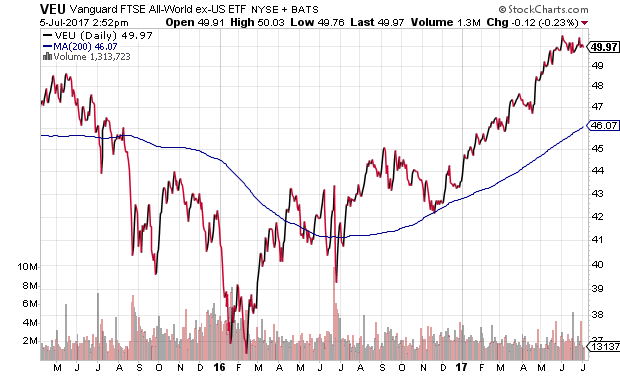
So what did central banks do? The European Central Bank (ECB) as well as the Bank of Japan (BOJ) increased their quantitative easing asset purchases dramatically. Meanwhile, the Fed abandoned plans for four rate hikes in 2016, opting for a single one in December.
Once again, central bank policy had stopped rapid price depreciation in its tracks. In fact, ever since global central banks ratcheted up the electronic money creation, riskier assets across the world have catapulted higher to 52-week peaks or all-time records.
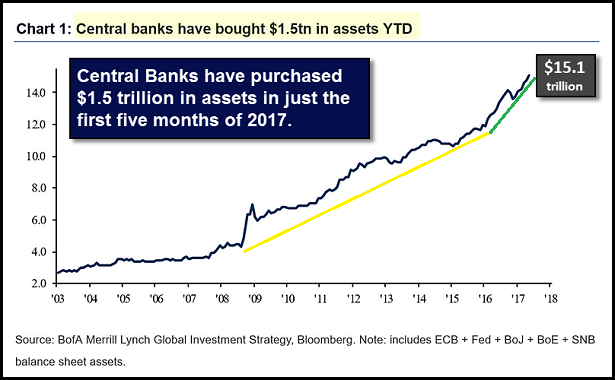
Putting some of what has been taking place into perspective, the Swiss National Bank (SNB) owns close to $80 billion in U.S. stocks (June, 2017). That’s up from $63 billion at the beginning of the year. That makes the land of luxury watches and high quality chocolate the eighth largest public shareholder of U.S. equities. They own more publicly traded shares of Facebook (NASDAQ:FB) than founder, Mark Zuckerberg. And they’d have to be one of the largest owners of Apple (NASDAQ:AAPL) as well.
Below is a representation of the SNB’s Q1 purchases over the prior quarter. The purchasing activity across all of these stocks is nothing short of amazing. Why wouldn’t stocks go higher as long as central banks are directly (and indirectly) acquiring U.S. stocks? Equally compelling? Get a gander of the blue bars on Facebook (FB), Apple (AAPL), Amazon (NASDAQ:AMZN) and Google/Alphabet (GOOG). The quarter-over-quarter jump in these “FAANG” stocks go a long way toward explaining their remarkable price run-up in 2017.
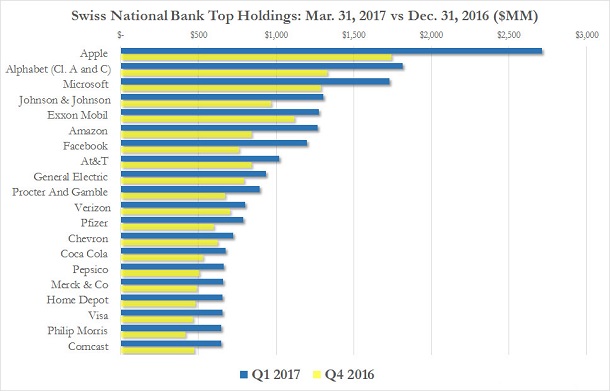
Perhaps unfortunately, there aren’t enough people asking what happens when central banks reduce their holdings. It is almost as if investors have been lulled into a false sense of security that central bank manipulation of equity prices, the cost of capital (i.e., borrowing costs) and the amount of capital (i.e. liquidity) will always be favorable to them.
Let’s consider an example in the arena of borrowing costs. High-yield bond investors currently do not believe that central banks will ever let key borrowing rates move meaningfully higher. For that matter, they are not currently concerned about defaults in the energy or retail sectors, in spite of below-$50-per-barrel crude and 1000s of brick-n-mortar store closings. In fact, junk-rated corporate bonds are on track for record-setting demand in 2017.
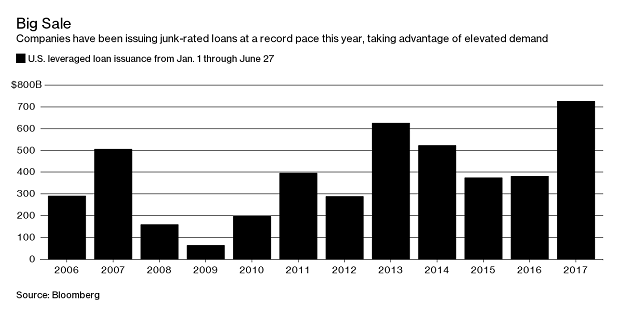
Whereas the historical spread between high yield junk bonds and comparable Treasuries is roughly 5.5%, the BofA Merrill Lynch US High Yield Option-Adjusted Spread is a meager 3.7%. That’s negligible reward for a whole lot of risk of financial loss.
The pervasive belief is that price gains can go on indefinitely as long as central banks continue their support. One sees it in repressed volatility that has been mimicking the onset of the 2007 financial crisis. One sees it in leverage ratio extremes like corporate debt-to-GDP.
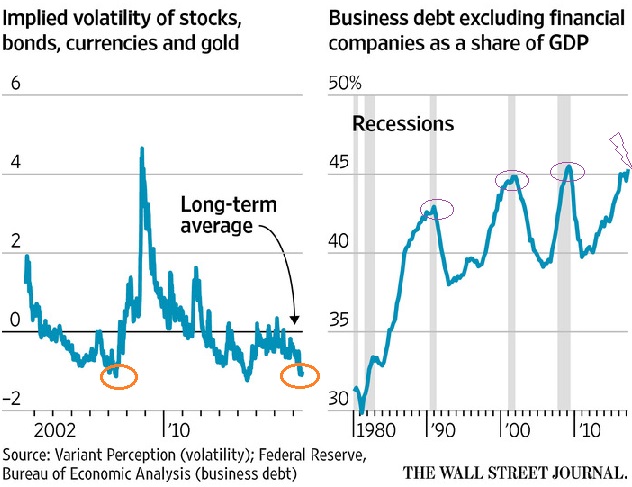
The big picture that many may be overlooking is the probability of central bank policy error. For one thing, the Fed has picked up its pace on hiking the overnight lending rate and has talked openly about reducing its balance sheet. Other central banks like the Bank of England and the European Central Bank have been dropping hints about less accommodating monetary policies.
It follows that investors would have to believe in an unblemished transition from monetary policy authorities to political leadership worldwide – a hand-off that simultaneously embraces less liquidity alongside economic acceleration. I don’t see it. Neither does the International Monetary Fund (IMF). If anything, we’re more likely to see the same-old, sub-par 2% GDP in the U.S. That could be troublesome in an asset reflation world that has been entirely dependent on seemingly endless stimulus.
Another potential issue? Central bank support may become less politically acceptable. In the U.S. alone, three-fifths of Americans have seen their inflation-adjusted household income decline in the 21st century. Meanwhile, the inflation-adjusted income for the top 20% is at an all-time high. Household net worth by quintiles show similar disparities.
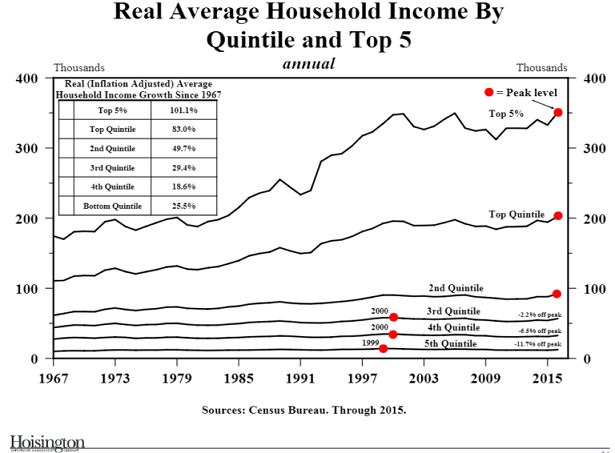
It follows that 21st century Fed policy of keeping rates extremely low for extended periods may eventually be viewed as unacceptable transfers of wealth from the poor to the rich. Should that be the case, Fed policy makers may feel compelled to continue tightening, even into the next recession, before eventually looking to accommodate once more.
Bottom line? When riskier asset prices decline, the very same credit flow that helped support higher prices disappears. That credit crunch exacerbates the depreciation. And yet, the notion that a Fed backstop will hold prices up at that time is not a slam dunk. The Fed’s vice chairman has already warned that “Elevated asset valuation pressures today may be indicative of rising vulnerabilities tomorrow.” In other words, folks, you may very well be on your own.
Disclosure Statement: ETF Expert is a web log (“blog”) that makes the world of ETFs easier to understand. Gary Gordon, MS, CFP is the president of Pacific Park Financial, Inc., a Registered Investment Adviser with the SEC. Gary Gordon, Pacific Park Financial, Inc., and/or its clients may hold positions in the ETFs, mutual funds, and/or any investment asset mentioned above. The commentary does not constitute individualized investment advice. The opinions offered herein are not personalized recommendations to buy, sell or hold securities. At times, issuers of exchange-traded products compensate Pacific Park Financial, Inc. or its subsidiaries for advertising at the ETF Expert website. ETF Expert content is created independently of any advertising relationship.
